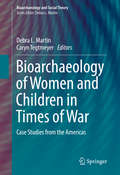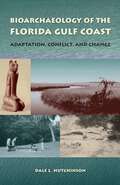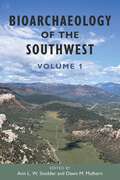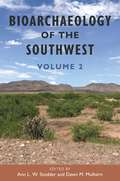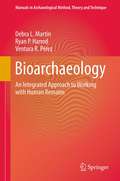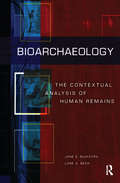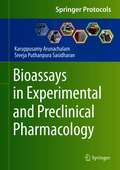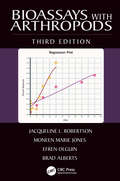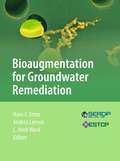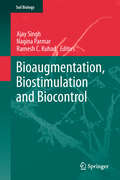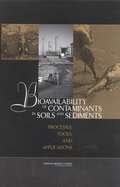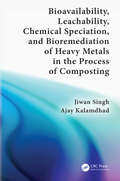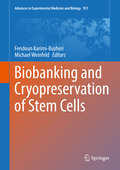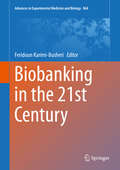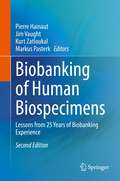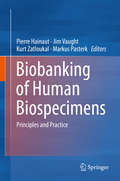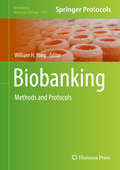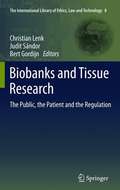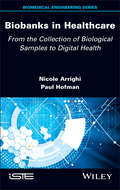- Table View
- List View
Bioarchaeology of Women and Children in Times of War: Case Studies from the Americas (Bioarchaeology and Social Theory)
by Debra L. Martin Caryn TegtmeyerThis volume will examine the varied roles that women and children play in period of warfare, which in most cases deviate from their perceived role as noncombatants. Using social theory about the nature of sex, gender and age in thinking about vulnerabilities to different groups during warfare, this collection of studies focuses on the broader impacts of war both during warfare but also long after the conflict is over. The volume will show that during periods of violence and warfare, many suffer beyond those individuals directly involved in battle. From pre-Hispanic Peru to Ming dynasty Mongolia to the Civil War-era United States to the present, warfare has been and is a public health disaster, particularly for women and children. Individuals and populations suffer from displacement, sometimes permanently, due to loss of food and resources and an increased risk of contracting communicable diseases, which results from the poor conditions and tight spaces present in most refugee camps, ancient and modern. Bioarchaeology can provide a more nuanced lens through which to examine the effects of warfare on life, morbidity, and mortality, bringing individuals not traditionally considered by studies of warfare and prolonged violence into focus. Inclusion of these groups in discussions of warfare can increase our understanding of not only the biological but also the social meaning and costs of warfare.
Bioarchaeology of the Florida Gulf Coast: Adaptation, Conflict, and Change (Florida Museum of Natural History: Ripley P. Bullen Series)
by Dale L. HutchinsonIn Bioarchaeology of the Florida Gulf Coast, Dale Hutchinson explores the role of human adaptation along the Gulf Coast of Florida and the influence of coastal foraging on several indigenous Florida populations. The Sarasota landmark known as Historic Spanish Point has captured the attention of historians and archaeologists for over 150 years. This picturesque location includes remnants of a prehistoric Indian village and a massive ancient burial mound-- known to archaeologists as the Palmer Site--that is one of the largest mortuary sites uncovered in the southeastern United States. Interpreting the Palmer population (numbering over 400 burials circa 800 A.D.) by analyzing such topics as health and diet, trauma, and demography, Hutchinson provides a unique view of a post-Archaic group of Indians who lived by hunting, collecting, and fishing rather than by agriculture. This book provides new data that support a general absence of agriculture among Florida Gulf Coast populations within the context of great similarities but also substantial differences in nutrition and health. Along the central and southern Florida Gulf Coast, multiple lines of evidence such as site architecture, settlement density and size, changes in ceramic technology, and the diversity of shell and stone tools suggest that this period was one of emerging social and political complexity accompanied by population growth. The comparisons between the Florida Gulf Coast and other coastal regions illuminate our understanding of coastal adaptation, while comparisons with interior populations further stimulate thoughts regarding the process of culture change during the agricultural era. A volume in the Florida Museum of Natural History: Ripley P. Bullen Series
Bioarchaeology of the Southwest: Volume 1 (Bioarchaeological Interpretations of the Human Past: Local, Regional, and Global Perspectives)
by Clark Spencer LarsenA wide-ranging synthesis of research illuminating the lives of ancient people who lived in the deserts, mountains, and river valleys of the North American SouthwestThe two volumes of Bioarchaeology of the Southwest bring together more than 100 years of research into the lives of the ancient people of the Southwest United States and Northwest Mexico. Featuring contributions from specialists working in academic, museum, and cultural resource management settings, these books make available knowledge from a variety of unpublished sources that have been difficult to access until now.The volume 1 chapters range from Colorado to central New Mexico and the Lower Pecos region of Texas, addressing the bioarchaeology of the Archaic hunters and foragers, the Basketmaker II people, and communities of the Mesa Verde region, Chaco Canyon, the Middle San Juan or Totah region, the Northern Rio Grande, and the Middle Rio Grande. Chapters discuss topics such as morphology and stature, biodistance, paleopathology, dental health, evidence of injuries and violence, and mortuary practice.With chapters representing hundreds of ancient communities dating from the Archaic to the early Historic period, Bioarchaeology of the Southwest demonstrates the range of topics that can be addressed through the contextualized study of human remains, the insights this field offers into the everyday experiences of people in the past, and the challenges and promise of collaborative approaches to this research. Together, these volumes constitute an unparalleled resource for understanding the history of bioarchaeology and critical issues impacting the future of the discipline in the region.Contributors: Anna Osterholtz | Rachael Byrd | Genevieve Woodhead | Ann L. W. Stodder| Kristin A. Kuckelman | Dawn M. Mulhern | Robin M. Cordero | Lexi O'Donnell | Cherie K. Walth | Catrina Banks Whitley | Charles Hilton | Nancy J. Akins | Ann M. PalkovichA volume in the series Bioarchaeological Interpretations of the Human Past: Local, Regional, and Global Perspectives, edited by Clark Spencer Larsen
Bioarchaeology of the Southwest: Volume 2 (Bioarchaeological Interpretations of the Human Past: Local, Regional, and Global Perspectives)
by Clark Spencer LarsenA wide-ranging synthesis of research illuminating the lives of ancient people who lived in the deserts, mountains, and river valleys of the North American Southwest The two volumes of Bioarchaeology of the Southwest bring together more than 100 years of research into the lives of the ancient people of the Southwest United States and Northwest Mexico. Featuring contributions from specialists working in academic, museum, and cultural resource management settings, these books make available knowledge from a variety of unpublished sources that have been difficult to access until now. Chapters in volume 2 include northern and southern Arizona, southwest New Mexico, and northern Mexico. The contributors summarize findings about people of the Sinagua, Kayenta, Mimbres, Hohokam, and Trincheras traditions and the Casas Grandes region. Four topically focused chapters discuss evidence of cancer in the Southwest, biological distance in Colonial-era populations, stable isotope studies, and archaeoparasitology. The concluding chapter reviews the strengths and challenges in the field, and some avenues for progress. With chapters representing hundreds of ancient communities dating from the Archaic to the early Historic period, Bioarchaeology of the Southwest demonstrates the range of topics that can be addressed through the contextualized study of human remains, the insights this field offers into the everyday experiences of people in the past, and the challenges and promise of collaborative approaches to this research. Together, these volumes constitute an unparalleled resource for understanding the history of bioarchaeology and critical issues impacting the future of the discipline in the region. Contributors: M. Anne Katzenberg | Teresa Rodrigues | M. Elisa Villalpando | Lorrie Lincoln-Babb | Lara K. Noldner | Adrianne Offenbecker | Karl Reinhard | Kimberly Spurr | Chris Loendorf | Jeffrey Boyer | Heather J.H. Edgar | Dawn M. Mulhern | Rebecca J. Hill | Catrina Banks Whitley | Corey Ragsdale | Korri Turner | Morgana Camacho | Jessica I. Cerezo-Román | Kathryn M. Baustian | Debra L. Martin | Darrell G. Creel | Kyle Waller | Penny Dufoe Minturn | John McClelland | Courtney McConnan Borstad | T. Michael Fink | Claira Ralston | James T. Watson | Ann L. W. StodderA volume in the series Bioarchaeological Interpretations of the Human Past: Local, Regional, and Global Perspectives, edited by Clark Spencer Larsen
Bioarchaeology: An Integrated Approach to Working with Human Remains (Manuals in Archaeological Method, Theory and Technique #6)
by Ventura R. Pérez Debra L. Martin Ryan P. HarrodBioarchaeology is the analysis of human remains within an interpretative framework, including a wide range of contextual information. This comprehensive and much-needed manual provides both a starting point and a reference for archaeologists working in this integrative field. The authors cover a range of bioarchaeological methods and theory including: · Ethical issues involved in dealing with human remains, specifically related to NAGPRA · Field and taphonomic clues · Lab and Forensic techniques · Best practices methods for Excavation techniques · Special applications of Bioarchaeology · Theoretical frameworks of Bioarchaeology With case studies from over twenty years each of bioarchaeological research, the authors integrate theoretical and methodological discussion with a wide range of field studies, from different geographic areas, time periods, and data types, to demonstrate the full scope of this important field of study.
Bioarchaeology: An Introduction to the Archaeology and Anthropology of the Dead
by Mark Q. Sutton Eric J. BartelinkBioarchaeology covers the history and general theory of the field plus the recovery and laboratory treatment of human remains.Bioarchaeology is the study of human remains in context from an archaeological and anthropological perspective. The book explores, through numerous case studies, how the ways a society deals with their dead can reveal a great deal about that society, including its religious, political, economic, and social organizations. It details recovery methods and how, once recovered, human remains can be analyzed to reveal details about the funerary system of the subject society and inform on a variety of other issues, such as health, demography, disease, workloads, mobility, sex and gender, and migration. Finally, the book highlights how bioarchaeological techniques can be used in contemporary forensic settings and in investigations of genocide and war crimes.In Bioarchaeology, theories, principles, and scientific techniques are laid out in a clear, understandable way, and students of archaeology at undergraduate and graduate levels will find this an excellent guide to the field.
Bioarchaeology: An Introduction to the Archaeology and Anthropology of the Dead
by Mark Q. SuttonBioarchaeology covers the history and general theory of the field plus the recovery and laboratory treatment of human remains. Bioarchaeology is the study of human remains in context from an archaeological and anthropological perspective. The book explores, through numerous case studies, how the ways a society deals with their dead can reveal a great deal about that society, including its religious, political, economic, and social organizations. It details recovery methods and how, once recovered, human remains can be analyzed to reveal details about the funerary system of the subject society and inform on a variety of other issues, such as health, demography, disease, workloads, mobility, sex and gender, and migration. Finally, the book highlights how bioarchaeological techniques can be used in contemporary forensic settings and in investigations of genocide and war crimes. In Bioarchaeology, theories, principles, and scientific techniques are laid out in a clear, understandable way, and students of archaeology at undergraduate and graduate levels will find this an excellent guide to the field.
Bioarchaeology: The Contextual Analysis of Human Remains (Bioarchaeology And Social Theory Ser.)
by Jane E. Buikstra Lane A. BeckThe core subject matter of bioarchaeology is the lives of past peoples, interpreted anthropologically. Human remains, contextualized archaeologically and historically, form the unit of study. Integrative and frequently inter-disciplinary, bioarchaeology draws methods and theoretical perspectives from across the sciences and the humanities. Bioarchaeology: The Contextual Study of Human Remains focuses upon the contemporary practice of bioarchaeology in North American contexts, its accomplishments and challenges. Appendixes, a glossary and 150 page bibliography make the volume extremely useful for research and teaching.
Bioassay Techniques for Drug Development
by Atta-ur-Rahman M. Iqbal Choudhary William J. ThomsenThe goal of an activity-directed isolation process is to isolate bioactive compounds which may provide structural leads of therapeutic importance. Whereas the traditional process of drug development is long and expensive, simple and rapid bioassays can serve as the starting point for drug discovery. This book presents a range of "bench top" bioassa
Bioassays in Experimental and Preclinical Pharmacology (Springer Protocols Handbooks)
by Karuppusamy Arunachalam Sreeja Puthanpura SasidharanThis detailed book explores protocols for a wide array of preclinical pharmacology and toxicology evaluations to be applied to chemical drugs and their development through in vitro, involving tissues and cell lines, and in vivo models, using animals as experimental systems, utilized to conduct pharmacological research. Written for the Springer Protocols Handbooks series, the methodologies included in this collection have been standardized by the authors through extensive use in the lab so that they are ready to be applied in the labs of readers around the world. Authoritative and practical, Bioassays in Experimental and Preclinical Pharmacology aims to assist undergraduate and postgraduate students, research scholars, scientists, and other academicians performing research in the vital field of drug discovery.
Bioassays with Arthropods
by Efren Olguin Brad Alberts Jacqueline Robertson Moneen JonesImagine a statistics book for bioassays written by a statistician. Next, imagine a statistics book for bioassays written for a layman. Bioassays with Arthropods, Third Edition offers the best of both worlds by translating the terse, precise language of the statistician into language used by the laboratory scientist. The book explains the statistical basis and analysis for each kind of quantal response bioassay in just the right amount of detail. The first two editions were a great reference for designing, conducting, and interpreting bioassays: this completely revised and updated third edition will also train the laboratory scientist to be an expert in estimation of dose response curves. New in the Third Edition: Introduces four new Windows and Apple-based computer programs (PoloJR, OptiDose, PoloMixture and PoloMulti) for the analyses of binary and multiple response analyses, respectively Replaces out-of-date GLIM examples with R program samples Includes a new chapter, Population Toxicology, and takes a systems approach to bioassays Expands the coverage of invasive species and quarantine statistics Building on the foundation set by the much-cited first two editions, the authors clearly delineate applications and ideas that are exceptionally challenging for those not already familiar with their use. They lead you through the methods with such ease and organization, that you suddenly find yourself readily able to apply concepts that you never thought you would understand. To order the PoloSuite computer software described in Bioassays with Arthropods, Third Edition, use the order form found at www.leora-software.com or contact the LeOra Software Company at leorasoftware@gmail.com.
Bioaugmentation Techniques and Applications in Remediation
by InamuddinIt has been observed that rapid population expansion has raised the amount of anthropogenic activity, resulting in high levels of pollution in water, air, and solid waste as well as an increase in the pressure placed on agricultural lands. Bioaugmentation Techniques and Applications in Remediation provides detailed information on bioaugmentation approaches for the remediation of sediments, water, and soil polluted with organic and inorganic pollutants. Practical applications of bioaugmentation techniques performed in restricted systems under controlled conditions, laboratory investigations, and in the field are addressed. Special emphasis is placed on the applications of nanomaterials in combination with bioaugmentation techniques for enhanced bioremediation efficiency. FEATURES Explores abiotic and biotic factors that enhance and facilitate environmental remediation of contaminants Provides a primer on the elementary microbial processes entailed in bioaugmentation Summarizes methods and approaches for executing bioaugmentation technology Details commercially available products and instrumentation This book is an ideal resource for researchers, students, and engineers working in materials science and bioremediation.
Bioaugmentation for Groundwater Remediation (SERDP ESTCP Environmental Remediation Technology #5)
by C. Herb Ward Hans F. Stroo Andrea LeesonThis volume provides a review of the past 10 to 15 years of intensive research, development and demonstrations that have been on the forefront of developing bioaugmentation into a viable remedial technology. This volume provides both a primer on the basic microbial processes involved in bioaugmentation, as well as a thorough summary of the methodology for implementing the technology. This reference volume will serve as a valuable resource for environmental remediation professionals who seek to understand, evaluate, and implement bioaugmentation.
Bioaugmentation, Biostimulation and Biocontrol (Soil Biology #10)
by Ajay Singh Ramesh C. Kuhad Nagina ParmarBioaugmentation, biostimulation and biocontrol approaches using microbial inoculants, biofertilizers, biochemicals and organic amendments improve soil biology, fertility and crop productivity by providing plant growth-promoting nutrients and suppressing soil-borne diseases and plant-parasitic nematodes. Our knowledge of microbial diversity and its function in soils has been increased tremendously due to the availability of a wealth of data gained through recent advances in the development of molecular methods and metagenomics for the evaluation of microbial diversity and functions in the rhizosphere environment of soil. Chapters dealing with the application of biofertilizers and organic amendments are contributed by experts - authorities in the area of soil science including microbiology and molecular biology - from academic institutions and the industry.
Bioavailability Of Contaminants In Soils And Sediments: Processes, Tools, And Applications
by Committee on Bioavailability of Contaminants in Soils SedimentsBioavailability refers to the extent to which humans and ecological receptors are exposed to contaminants in soil or sediment. The concept of bioavailability has recently piqued the interest of the hazardous waste industry as an important consideration in deciding how much waste to clean up. The rationale is that if contaminants in soil and sediment are not bioavailable, then more contaminant mass can be left in place without creating additional risk. A new NRC report notes that the potential for the consideration of bioavailability to influence decision-making is greatest where certain chemical, environmental, and regulatory factors align. The current use of bioavailability in risk assessment and hazardous waste cleanup regulations is demystified, and acceptable tools and models for bioavailability assessment are discussed and ranked according to seven criteria. Finally, the intimate link between bioavailability and bioremediation is explored. The report concludes with suggestions for moving bioavailability forward in the regulatory arena for both soil and sediment cleanup.
Bioavailability of Organic Chemicals in Soil and Sediment (The Handbook of Environmental Chemistry #100)
by Jose Julio Ortega-Calvo John Robert ParsonsThis book discusses bioavailability concepts and methods, summarizing the current knowledge on bioavailability science, as well as possible pathways for integrating bioavailability into risk assessment and the regulation of organic chemicals. Divided into 5 parts, it begins with an overview of chemical distribution in soil and sediment, as well as the bioavailability and bioaccumulation of chemicals in plants, soil, invertebrates and vertebrates (including humans). It then focuses on the impact of sorption processes and reviews bioavailability measurement methods. The closing chapters discuss the impact of bioavailability studies on chemical risk assessment, and highlights further research needs. Written by a multi-disciplinary team of authors, it is an essential resource for scientists in academia and industry, students, as well as for authorities.
Bioavailability, Leachability, Chemical Speciation, and Bioremediation of Heavy Metals in the Process of Composting
by Jiwan Singh Ajay KalamdhadCurrently, it is a serious concern to manage waste in the environment. Therefore, detailed knowledge of heavy metals, their eco-toxicological and health effects and ecofriendly approaches for their immobilization and detoxification is urgently required to control and minimize the environmental pollution. Composting is one of the popular methods in waste management and there are a lot of issues pertaining to composting. One of it is the leaching of heavy metals. This book discusses thoroughly, the availability, leachability and the speciation of heavy metals in the entire process of composting.
Bioavailability: Physical, Chemical, and Biological Interactions
by William H. Benson Jerry Hamelink Peter F. Landrum Harold BergmanPractical and provocative, Bioavailability reviews prevalent understanding of the physical-chemical-biological mechanisms that control the bioavailability of both organic and inorganic contaminants in aquatic environments.Discusses the complex issues that surround many regulatory issues Emphasizes the need to identify and control that portion of the total concentration that is biologically available and can cause adverse effects, i.e., "active" Examines the influence of dynamic factors, such as pH, alkalinity, and light on these mechanisms Addresses the subject of speciation for both organic and inorganic contaminants
Biobanking and Cryopreservation of Stem Cells (Advances in Experimental Medicine and Biology #951)
by Feridoun Karimi-Busheri Michael WeinfeldBiobanking is considered to be one of the ten ideas changing the world with an estimated value of $45 billion by 2025. Despite the challenges, as the climate for innovation in the biobanking industry continues to flourish around the world, it is certain that amazing discoveries will emerge from this large-scale method of preserving and accessing human samples; biobanking is no longer just a place for collecting and storing samples. This book will cover a wide variety of subjects from across the future biobanking spectrum including scientific strategies, personalized medicine, regenerative medicine and stem cell challenges, disease surveillance, population genetics and innovative methods of biobanking.
Biobanking in the 21st Century: Volume I - Techniques (Advances in Experimental Medicine and Biology #864)
by Feridoun Karimi-BusheriBiobanking, an emerging field supported by academia, industry and health administrators alike, is distinctly different today from the practice that once defined it. The science of Biobanking, which initially involved simply storing blood or tissue samples in a freezer, is now a highly sophisticated field of research, and expected to grow exponentially over the next decade or two. This book aims to serve the purpose of further enriching the available literature on Biobanking, by offering unique and more useful collection of ideas for the future. The book outlines the experiences of developing modern Biobanking repositories in different countries, whilst covering specific topics regarding the many aspects of Biobanking. This book will be of interest to a wide range of readers including: academics, students, volunteers and advocates of patients' rights.
Biobanking of Human Biospecimens: Lessons from 25 Years of Biobanking Experience
by Pierre Hainaut Jim Vaught Kurt Zatloukal Markus PasterkOver the past 25 years, biobanks of human specimens have become a cornerstone for research on human health and have empowered the “omics “revolution that characterizes biomedical science in the XXIst Century. Today, biobanking of human specimens is a critical component of the interface between clinical practice and translational research, supporting the discovery and validation of new biomarkers of disease etiology, risk, early detection, diagnosis, prognosis, prediction and relapse. With the development of personalized medicine, biobanking of cryopreserved specimens has become standard practice in order to investigate genetic, transcriptomic, proteomic, metabolomics and immunological biomarkers useful to inform caregivers for therapeutic decisions. Data generated from biobanked specimens represent a rapidly growing and highly valuable resource, participating in the emergence of Big Data Medicine. With the development of large computing capabilities and artificial intelligence, data associated with biobanked specimens constitute a unique resource for the discovery and validation of new biomarkers and therapeutically actionable targets. Interconnecting, interoperating and sharing this data have become major issues for national health systems, raising enormous stakes as well as major societal, legal and cybersecurity challenges in terms of compliance with the protection of personal sensitive information. This book project is the second part of an initiative launched in 2012 to produce a published corpus of knowledge encompassing all aspects of human biobanking as a central practice for research and medicine. The first volume, published in 2017, is entitled: Human Biobanking: Principles and Practice. This first volume compiled a series of high level contributions overseeing the main developments that carried the progression of human biobanking as a research and biotechnological field over the past two decades. This new book project will constitute de facto Volume 2 of the same initiative, under the title: Biobanking of Human Biospecimens: lessons from 25 years of biobanking experience. Hence, the two volumes will share the same generic title (Biobanking of Human Biospecimens), with different subtitles, making clear that the two volumes are interrelated while highlighting their specificities in terms of what they actually cover. As a result, the two books are “twins” but can also be used independently of each other.The overarching aim of the two volumes of Biobanking of Human Biospecimens is to provide a published “one-stop shop” for state-of-the-art information on what constitutes the field of human biobanking, from conception of a biobank, standard operating procedures, ethical and societal aspects, governance, networking, interoperability and economic sustainability. This inclusive publication concept meets the needs of a vast readership, including scientists, doctors and technical staffs who are directly involved in biobanking operations, scientists in other disciplines that heavily rely on biobanking (such as genomics or proteomics), stakeholders and policy makers, and of course students for whom biobanking is becoming an important part of the training curriculum. So far, there has been a lack of major textbooks on biobanking. Documentation for biobanking is widely available through numerous publications, regulatory documents published by International or Governmental Agencies, and sets of recommendations essentially accessible through the Internet. However, it is difficult to access a single, top-of-the shelf reference that provides at a glance a large coverage of all aspects of human biobanking. Fulfilling this need is the main origin of the concept for this back-to-back publication project. To our knowledge, there is currently no other publication project with the same breath and scope as this one in the field of biobanking.
Biobanking of Human Biospecimens: Principles and Practice
by Pierre Hainaut Jim Vaught Kurt Zatloukal Markus PasterkThis volume is the first comprehensive text on human biobanking, authored by scientists and regulatory officers who have led the field over the past 10 years. It covers biobanking issues and its importance in advancing the field of research in cancer, cardiovascular, metabolic, and other diseases. Biobanks of human specimens have become the cornerstone for research on human health that harnesses the power of "omics" technologies to identify biomarkers for disease susceptibility. Biobanks are an essential component of the development of personalized medicine, which relies on the molecular analysis of biospecimens that are truly representative of individuals and of diseases. Over the past decade, biobanking has been the focus of major investments and developments aimed at developing appropriate infrastructure, methods, networking practice and evidence-based pre-analytical procedures. This volume explores topics including specimen storage, protocol design, specimen collection, pre-analytical processing and preservation, long-term storage, retrieval and separation, and distribution to analytical laboratory platforms. These activities are extremely complex and are essential for biomedical and biotechnological developments and this text provides critical information about biobanking for the development of future forms of medicine.
Biobanking: Methods And Protocols (Methods in Molecular Biology #1897)
by William H. YongThis volume not only discusses various common biobanking topics, it also delves into less-discussed subjects such as what is needed to start a biobank, training of new biobanking personnel, and ethnic representation in biospecimen research. Other chapters in this book span practical topics including: disaster prevention and recovery; information technology; flora and fauna preservation including zoological fluid specimen photography; surgical and autopsy biobanking; biobanking of bodily fluids; biosafety; cutting frozen sections; immunohistochemistry; nucleic acid extraction; and biospecimen shipping. Written in the highly successful Methods in Molecular Biology series format, chapters include introductions to their respective topics, lists of the necessary materials and reagents, step-by-step, readily reproducible laboratory protocols, and tips on troubleshooting and avoiding known pitfalls.Unique and comprehensive, Biobanking: Methods and Protocols is a valuable resource for novice and practicing biobankers, and for end-user researchers. This book aims to bring new insight into the field and expand on current biomedical biobanking studies.
Biobanks and Tissue Research: The Public, the Patient and the Regulation (The International Library of Ethics, Law and Technology #8)
by Bert Gordijn Judit Sándor Christian LenkThe research field of biobanks and tissue research is highly promising. Many projects around the globe are involved in the collection of human tissue and health data for research purposes. These initiatives are driven by the perspective of decisive breakthroughs in the knowledge of the genetic pathways involved in widespread diseases. However, there are considerable ethical and legal challenges to be considered as well. These challenges encompass the use of body material for research purposes, the misuse of genetic and other health data by third parties, trust in science and medicine, concerns regarding privacy, use of genetic data for forensic applications by the state and the police, and regulatory issues. This volume is divided into three parts: the inclusion of the public, the rights of donors and patients, examples and recommendations for the future of tissue research. It presents a comprehensive overview of the most important topics in the field by renowned scholars in medical ethics and biolaw.
Biobanks in Healthcare: From the Collection of Biological Samples to Digital Health (ISTE Invoiced)
by Paul Hofman Nicole ArrighiBiobanks ensuring the governance and management of biological resources have become essential entities. The development of biotechnologies, the increased prevalence of biological drugs and the identification of biomarkers associated with molecular classifications of tissue lesions make it essential to have organized access to human biological samples, which have become precious and rare. The digital era and the production of massive data that comes with it have rendered biobanks the guarantors of the reproducibility of experiments and of the overall quality of medical research. Biobanks in Healthcare explores the upheaval linked to the massive deployment of digital health and precision medicine. The future of health biology lies in the deployment of biobanks in fields that have yet to be explored, putting them at the forefront of this extraordinary 21st-century research adventure.
